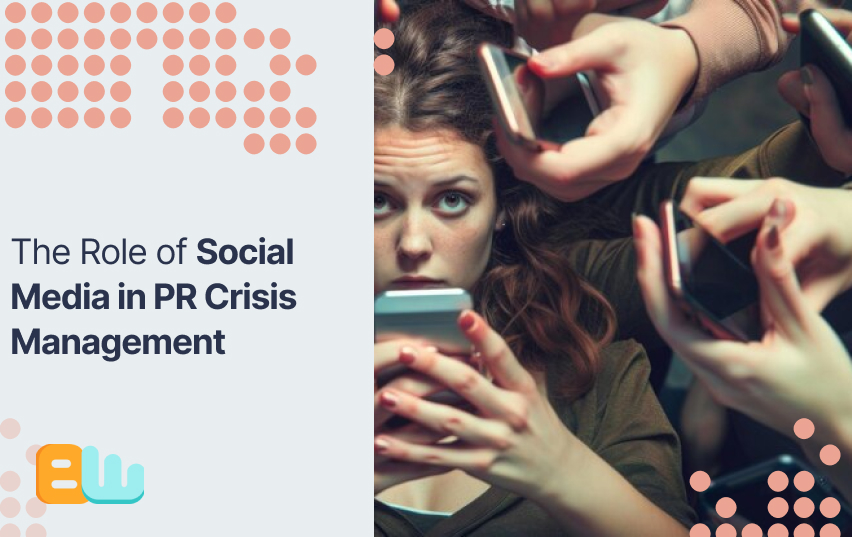
Today, if your brand experiences a PR issue, it spreads quickly on social media. Before your team has even convened to consider a response, a single bad tweet might become viral, garnering thousands of shares.
I’ve watched countless brands struggle with this new reality of crisis management. The days of releasing a well-planned press release and putting off fixing issues until morning are long gone.
In this post, I’ll demonstrate how social media has completely changed crisis management and offer doable tactics to save your business in the event of a social media disaster—not if it happens.
Understanding Social Media’s Impact on Modern Crisis Management
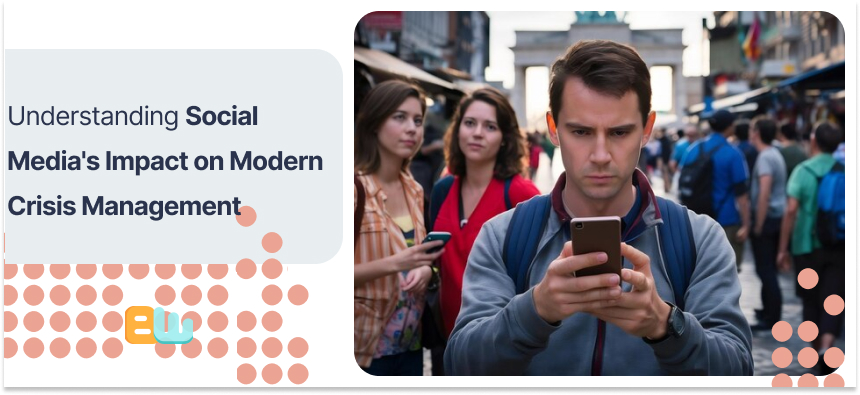
The way that businesses must handle reputation management has been drastically altered by the digital environment. Ten years ago, it would have been impossible to predict how today’s crises would evolve, spread, and end.
How Crisis Communication Has Evolved in the Digital Age
Do you recall the days when crisis management entailed setting up media interviews and writing press releases? Now, those times seem nearly archaic.
Before social media, companies usually had hours or even days to come up with solutions for new problems. Through highly regulated channels, communication mostly went in one direction: from the brand to the general public.
The reality of today is very different. These days, crisis communication takes place in real time, with numerous discussions taking place at once on different platforms. Your audience is actively contributing to the story’s development rather than only consuming information.
According to crisis communication specialist Melissa Agnes, “the timeline for crisis response has compressed from days to minutes.” “Companies that don’t adapt to this new velocity find themselves constantly playing defense.”
Because of this progression, brands need to be able to respond quickly and stay vigilant on all social media platforms where their target audience is active.
Why Social Media Makes Crisis Management More Complex
Social media has introduced several factors that significantly complicate crisis management:
First, information spreads exponentially. A single negative post can reach millions before your team has even been alerted to the issue. Problems intensify much more quickly than in traditional media cycles due to the viral nature of social material.
The distinctions between stakeholders are also blurred by platforms. The same public discourse is engaged in by your critics, investors, staff, and customers. All audiences can instantly see messages that are specifically designed for one audience.
Third, the fastest-moving information is emotive. Content that elicits strong emotional reactions, especially wrath or outrage, spreads more quickly than neutral information, according to numerous studies. This creates an environment where crises naturally amplify.
Context collapse is real, at last. An old piece of content can create new crises by being screenshotted, disseminated, and reinterpreted in entirely different circumstances.
5 Key Statistics Revealing Social Media’s PR Impact
The numbers tell a compelling story about social media’s influence on modern crisis management:
1. Only 30% of customers post positive experiences on social media, compared to 59% who post negative ones (Zendesk).
2. According to the Harvard Business Review, negative news reaches over twice as many individuals as positive news.
3. 86% of consumers say authenticity is important when deciding which brands to support during controversies (Stackla)
4. While social media users demand replies within an hour, organizations often take 21 hours to provide effective reactions to emergencies (Clutch).
5. According to the Edelman Trust Barometer, businesses that successfully handle crises within the first 48 hours often get 33% fewer bad press.
These figures demonstrate the opportunities and difficulties social media poses for crisis management.
Essential Social Media Tools for Effective Crisis Response
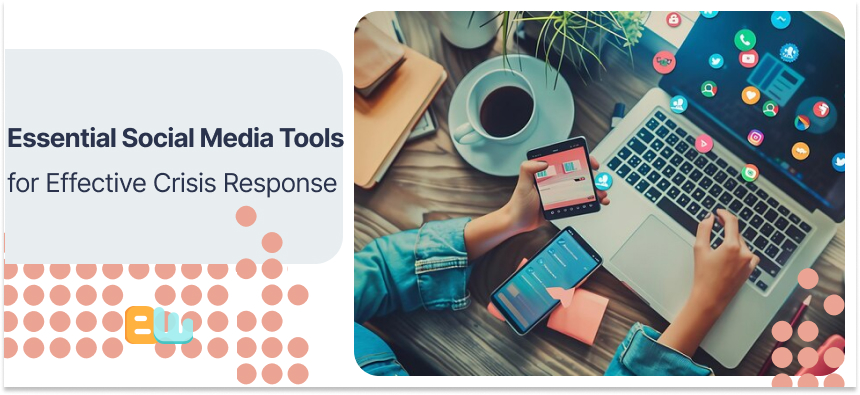
The proper technological stack can mean the difference between a problem being contained early on and getting out of control.
Real-Time Monitoring Platforms Every PR Team Needs
Your best line of protection against social media problems is still early identification. Every PR practitioner should have the following monitoring tools in their toolbox:
Mention monitors brand mentions on blogs, forums, news websites, and social media platforms. Potential problems are identified via its real-time notifications before they become more serious.
Brandwatch provides sophisticated sentiment analysis and is able to identify anomalous increases in conversation volume, which are frequently the first sign of impending disaster.
Talkwalker offers strong alert systems together with extensive social listening. Its Quick Search feature allows teams to immediately assess developing situations.
Hootsuite Teams can track discussions and participate immediately from a single dashboard thanks to this tool integration of monitoring and response tools.
You need systems that can distinguish between routine complaints and genuine crisis signals.
Set up separate monitoring streams for:
– Direct brand mentions
– Industry keywords
– Competitor issues (which could affect you)
– Key executive names
– Product-specific terms
How Analytics Software Helps Track Crisis Development
Analytics tools assist you in comprehending the extent and course of a possible catastrophe once it materializes:
To help you assess whether a problem is becoming worse or getting better, Sprout Social’s reporting suite shows you how the volume and tone of conversations vary over time.
BuzzSumo determines which influencers are spreading the word and which content about your situation is getting the most attention.
Google Analytics displays real-time website traffic trends, demonstrating how press coverage or social media discussions are bringing people to your website.
CrowdTangle Monitors the dissemination of brand stories on various platforms for media companies.
“Analytics during a crisis shouldn’t just measure the problem,” says digital strategist Jay Baer. They ought to direct your reaction by outlining precisely where and how to allocate your resources.
Integrating Social Listening into Your Crisis Strategy
By exposing the underlying sentiment and context of remarks, social listening transcends simple monitoring. Here’s how to successfully incorporate it:
Establish baseline measures during regular business activities first. You can spot unusual activity more immediately if you are aware of your normal mention volume, sentiment ratios, and interaction patterns.
Second, use these baselines to establish tier-based alert thresholds. While major deviations prompt quick response methods, minor variances may require observation.
Third, designate particular team members to do more than merely gather listening data; they should also analyze it. Social listening is only useful if someone can decipher the implications of the data for your company.
Fourth, create a feedback loop in which your reaction plan is directly influenced by listening findings. Make the necessary adjustments if sentiment analysis reveals that your first remark was inadequate.
Keep in mind that good listening records the larger context of the conversation as well as what people are saying about you. Adjacent conversations that don’t specifically address your brand might occasionally yield the most insightful information.
Developing a Social Media Crisis Management Plan
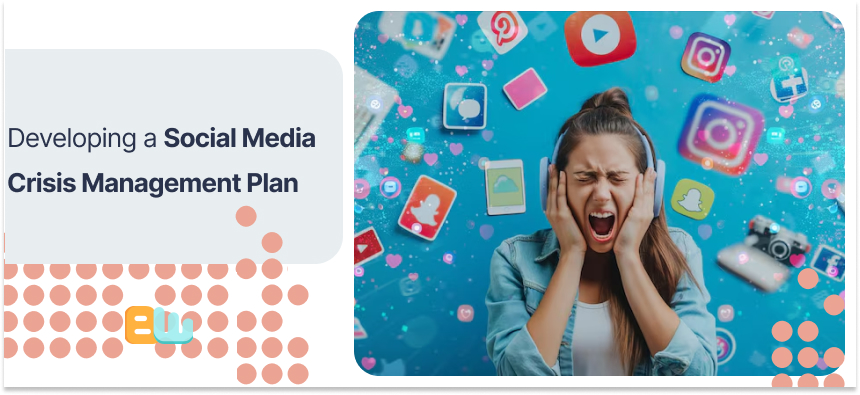
While no company can avoid every catastrophe, having a thorough strategy significantly increases the efficacy of your reaction.
Critical Components of a Social-First Response Strategy
A strong social media crisis plan includes several essential elements:
Clear crisis definition criteria: Not every negative mention constitutes a crisis. Define specific thresholds based on mention volume, sentiment shift, and involvement of influential accounts that trigger your crisis protocol.
Decision free response: Make a flowchart that assigns the proper response levels to the various crisis kinds. This enables teams to swiftly ascertain if a problem can be resolved through conventional procedures or calls for executive participation.
Pre-approved message templates: Develop frameworks for common crisis scenarios. While each situation requires customization, having approved language foundations saves critical time.
Designated spokesperson system: Identify who is authorized to speak on different platforms during various crisis levels. In the event that the primary contacts are unavailable, include backup speakers.
Escalation protocols: Clearly define when to refer matters to external crisis professionals, legal counsel, or leadership.
Hub for central communication: Decide on a unique digital site to store and distribute to the response team all crisis-related data, updates, and authorized messaging.
The most effective crisis plans are:
– Simple enough to be usable under pressure
– Flexible enough to adapt to unexpected scenarios
– Detailed enough to eliminate confusion about responsibilities
– Practiced regularly through simulation exercises
Creating Clear Response Guidelines for Various Platforms
Each social platform has unique characteristics that influence crisis communication. Effective plans account for these differences:
Twitter: Make direct communication, frequency, and conciseness your top priorities. The dynamic nature of Twitter frequently necessitates more regular updates. For intricate explanations, think about employing threads while keeping the core point constant.
Facebook: Develop more comprehensive statements that address multiple stakeholders. Be prepared for extensive comment management, as conversations can continue for days. Consider when to use private messaging versus public responses.
Instagram: Focus on visual communication elements. Prepare crisis response templates that align with your visual brand. Choose how to handle problems in Stories as opposed to the main feed and whether to suspend scheduled material.
LinkedIn: Create messages with a professional tone that are suitable for investors, business audiences, and industry partners.
YouTube: Establish guidelines for video responses, including production timelines, spokesperson selection, and comment management strategies.
For each platform, clearly define:
– Appropriate response tone
– Expected response time windows
– Content approval processes
– Comment moderation approaches
Who Should Be on Your Digital Crisis Response Team?
Building the right team is necessary for effective crisis management. Your core response team should include:
Social Media Manager: Provides platform expertise and frontline response capabilities. Usually the first to notice new problems.
Director of PR and Communications: makes certain that the messaging is in line with the brand voice and the larger communication plan.
Legal Counsel: Examines statements to address liability issues and offers guidance on any regulatory ramifications.
The customer service agent is: helps with the resolution of specific complaints and contributes the viewpoint of the consumer.
Sponsor Executive: acts as an escalation point and gives decision-making authority for significant reaction actions.
Subject Matter Expert: Supplies technical information relevant to specific crisis types (varies based on situation).
For larger organizations, consider additional roles:
– Dedicated crisis analyst to monitor response effectiveness
– Internal communications specialist to keep employees informed
Before a crisis arises, clearly define each team member’s responsibility and make sure they all understand it. Clarifying who has the last say in a developing crisis is not the time to do so.
7 Common PR Crisis Scenarios on Social Media
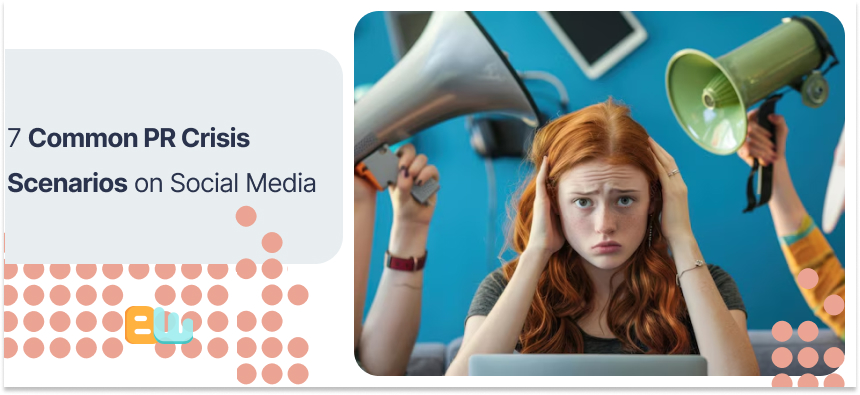
Understanding typical crisis patterns helps you prepare more effectively. Here are scenarios most brands eventually face:
Viral Customer Complaints: Containment Strategies That Work
Quick action is crucial when a consumer complaint garners a lot of attention. Among the components of effective containment are:
1. Acknowledge promptly: Within 30 to 60 minutes, publicly address the initial complaint, even if it’s only to say that you’re looking into it.
2. Take conversations private when appropriate: After public acknowledgment, move detailed resolution discussions to direct messages. This shows responsiveness while preventing additional public escalation.
3. Resolve the particular issue first: Take care of the problem with a single consumer before addressing more general issues. This shows more than simply damage control; it shows real concern.
4. Share resolution publicly: Once resolved, post a follow-up summarizing actions taken (with customer permission if referencing specifics).
5. Take preventative action: Declare specific actions to avoid reoccurring circumstances, demonstrating that this wasn’t a one-off reaction.
Starbucks successfully applied this strategy in the wake of a widely publicized racial bias incident. They recognized the particular circumstance, worked directly with the parties involved to fix it, and then instituted training for the entire organization to address the underlying problem.
Managing Negative Reviews and Reputation Damage
Review platforms present unique challenges during reputation crises:
1. Resist defensive responses: Avoid contradicting negative reviewers publicly. Rather, express gratitude for their input and show how you’re resolving issues.
2. Identify trend versus outlier reviews: Assess if bad reviews are a reflection of isolated instances or systematic problems that call for operational adjustments.
3. Activate happy customers: Motivate contented clients to naturally share their stories. Positive ratings should never be rewarded during times of crises because this comes seen as manipulative.
4. Create a review response rubric: Establish rules for various review formats to guarantee uniform, pertinent answers from any team member.
5. Improvements to the document: After making adjustments in response to feedback, revise your answers to demonstrate how the suggestions resulted in tangible enhancements.
Responding to Misinformation and False Accusations
False information presents particularly challenging crisis scenarios:
1. Assess reach before responding: Sometimes addressing minor misinformation only amplifies it. Evaluate spread before determining response level.
2. Lead with facts, not accusations: Instead of calling something “fake,” just authoritatively and plainly convey true information.
3. When feasible, present visual proof: Data visualizations, pictures, or images can successfully refute misleading narratives in ways that words alone cannot.
4. Involve third-party validators: Credibility is higher for independent specialists who validate your position than for self-defense.
5. Consider legal action carefully: While sometimes necessary, legal threats often escalate public interest in misinformation.
Airbnb has effectively managed misinformation by maintaining a dedicated fact-checking resource page during periods of controversy, providing transparent data that media and customers can reference directly.
Response Time: Why Speed Matters in Digital Crisis
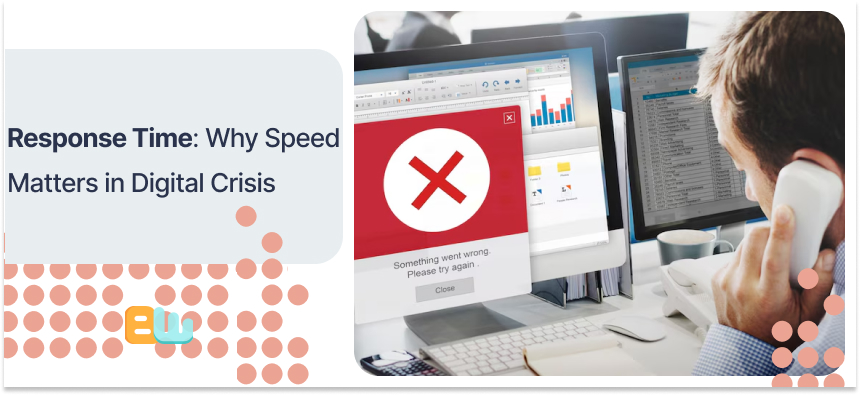
In the social media era, timing is a critical factor in crisis containment and resolution.
The Golden Hour: Timeframes for Initial Response
Crisis management professionals often reference “the golden hour”—the critical period immediately following crisis emergence when response effectiveness is maximized:
Research indicates that social media users expect initial responses within:
– 15-30 minutes for direct customer service inquiries during a crisis
– 30-60 minutes for acknowledgment of emerging public issues
– 1-2 hours for more substantial statements on developing situations
During this crucial window, even a brief acknowledgment that:
1. You’re aware of the situation
2. You take it seriously
3. More information is forthcoming
This simple communication can significantly impact how the crisis develops. According to surveys, 83% of consumers anticipate responses in a matter of hours, yet the typical brand response time is more than ten hours.
“The first message sets the tone for everything that follows,” says Melissa Agnes, a crisis counsellor. “Silence is interpreted as indifference, confusion, or guilt.”
Balancing Quick Reactions with Strategic Messaging
While speed matters, accuracy and thoughtfulness remain equally important. Here’s how to balance these competing priorities:
Develop a tiered response approach:
– Tier 1: Immediate acknowledgment (pre-approved templates)
– Tier 2: Initial position statement (requires minimal approval)
– Tier 3: Comprehensive response (requires fuller approval process)
Create a “holding statement” template library covering various scenarios. These provide breathing room while demonstrating responsiveness.
Establish rapid approval processes specifically for crisis situations. Standard marketing approval chains are typically too slow during active crises.
Designate pre-authorized responders who can acknowledge issues without escalation. Clear guidelines about what they can say independently prevent delays.
Implement concurrent workflows where investigation and initial response happen simultaneously rather than sequentially.
The Delta Airlines crisis team exemplifies this balanced approach. When system failures affect flights, their social team immediately acknowledges issues while operations teams gather facts, followed by regular updates as more information becomes available.
How Delayed Responses Amplify Social Media Crises
The repercussions of a delayed response are widely known:
Information vacuums fill quickly. Speculation and false information flood in when organizations fail to offer information. According to research, rumors tend to spread six times more quickly than explanations.
Control diminishes exponentially. Crisis management expert Timothy Coombs has documented how each hour of delayed response corresponds with decreased ability to influence the narrative.
The perception among the audience hardens. On social media, first impressions happen quickly. After adopting a specific perspective on a situation, consumers filter subsequent information using this preexisting lens.
Costs of recovery rise. Research continuously demonstrates that emergencies that are treated within the first hour need a lot less resources to fix than those that are left to fester.
These values are demonstrated by United Airlines’ tardy reaction to a 2017 passenger removal incident. Due to their 24-hour delay in taking substantial action, millions of people developed unfavorable opinions that took years to rectify.
Case Studies: Social Media Crisis Management Success Stories
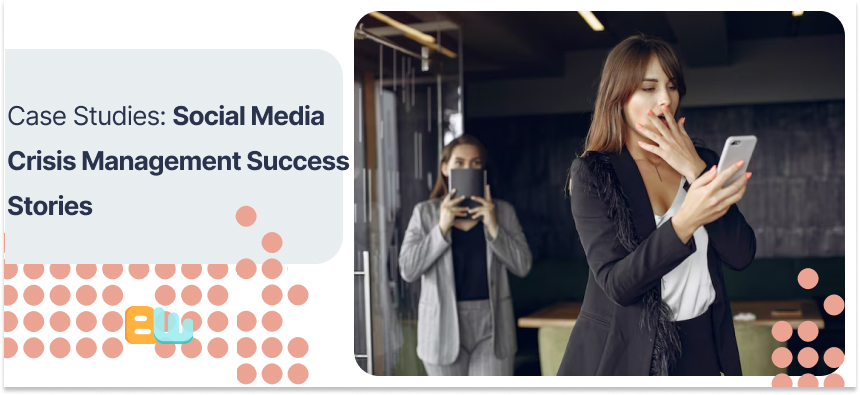
Gaining knowledge from both successful and unsuccessful crisis responses can help you plan more effectively.
How Major Brands Recovered from Social Media Disasters
Starbucks’ Racial Bias Recovery
The corporation received harsh criticism after a video went viral showing two Black men getting arrested while they were waiting at a Starbucks in Philadelphia. Their recovery approach included:
– An unequivocal apology from the CEO within 24 hours
– Closing 8,000 stores for racial bias training
– Revising store policies regarding bathroom use and customer seating
– Maintaining transparent communication throughout implementation
The result: While the incident damaged short-term perception, long-term metrics showed the brand recovered stronger by demonstrating authentic commitment to improvement.
Buffer’s Data Breach Transparency
When social media management platform Buffer experienced a significant hack affecting users’ accounts, they:
– Acknowledged the breach within 10 minutes of confirmation
– Provided hourly updates even when little new information existed
– Created a dedicated status page detailing their investigation and resolution steps
Their openness turned a possible catastrophe into a crisis management case study, and in the months that followed, client retention surpassed pre-crisis levels.
Domino’s Recipe for Recovery
When employees posted videos tampering with food, Domino’s:
– Quickly identified and fired the employees
– Posted a direct video response from the CEO
– Implemented new quality assurance measures
Analyzing Effective Crisis Communication Techniques
When these success stories are examined, common components of successful crisis management become apparent:
Immediate understanding of the problem is the first step in any effective crisis response. This initial acknowledgment doesn’t require complete information—just authentic engagement.
Consistent updates: Rather than waiting for complete resolution, effective crisis managers provide regular progress updates. This demonstrates ongoing commitment and reduces speculation.
Clear accountability: Successful responses clearly establish who is responsible for the situation and who is leading the solution. Avoiding accountability extends and amplifies crises.
Action orientation: Communication that emphasizes specific activities performs better than that which focuses on explanations. “Here’s what we’re doing” gets a better response from audiences than “Here’s why this happened.”
Proper channels: Crisis responses need to be present where discussions are taking place.
Companies that limit responses to their owned channels miss opportunities to directly engage where criticism is most active.
Human voice: Successful crisis communication uses natural language rather than corporate jargon. Legal-approved language that sounds inauthentic typically extends rather than resolves issues.
Lessons Learned from Notable PR Recovery Campaigns
These crisis recoveries offer valuable lessons for any organization:
1. Speed trumps perfection
In the UK, KFC’s chicken shortage would have proved disastrous. Rather, they swiftly replied with a funny “FCK” apologetic commercial. The approach worked because it was timely, authentic, and matched their brand voice—even without being perfect.
2. Demonstrate change, don’t just promise it
United Airlines eventually recovered by enacting and disclosing certain policy changes after an employee was caught on camera yanking a customer off an overbooked flight. Their recovery gained traction only when customers saw evidence of actual operational changes.
3. Use the right messenger
When Airbnb faced discrimination allegations, they recognized the importance of messenger selection. Rather than having only the CEO speak, they engaged affected community members and diversity experts to help shape and communicate their response, lending crucial credibility.
4. Turn detractors into advisors
Smart brands convert critics into consultants. After facing criticism about accessibility features, Microsoft actively recruited disability advocates to help improve their products, transforming potential detractors into partners in solution development.
5. Document the journey
The most effective recovery campaigns document their progress transparently. This approach—shown effectively by Starbucks during their racial bias response—demonstrates genuine commitment rather than crisis-driven posturing.
Building Brand Resilience Through Social Engagement
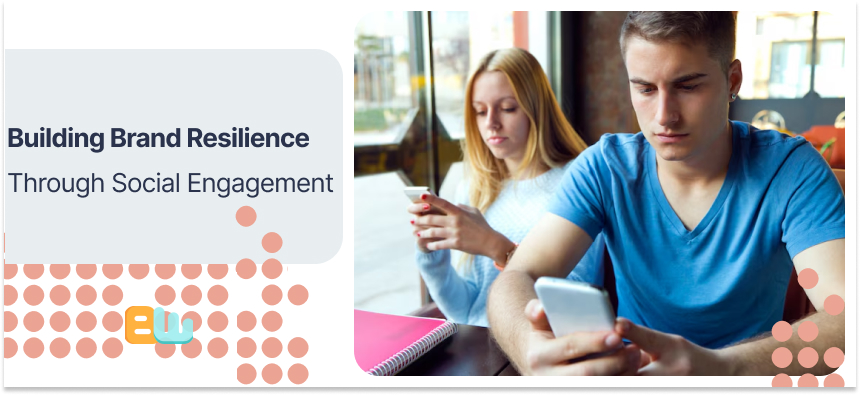
The best crisis management happens before crises emerge. Proactive engagement builds reputation reserves that provide cushioning during difficult periods.
Proactive Strategies to Prevent Social Media Crises
Implement these preventative measures to reduce crisis frequency and severity:
Conduct regular risk assessments identifying potential crisis triggers specific to your industry, company history, and current social climate. Review and update these quarterly.
Develop clear social media policies for employees that balance personal expression with organizational risk. Ensure guidelines address:
– Identifying when they’re speaking as employees versus individuals
– Handling confidential information
– Interacting with critics or competitors
– Reporting potential issues they observe
Implement approval workflows for sensitive content without creating bottlenecks for routine engagement. Use tiered review systems based on content risk level.
Monitor industry crises affecting similar organizations. Create scenario plans based on challenges your competitors face, as these often predict future issues for your brand.
Conduct simulation exercises at least twice yearly. These “fire drills” reveal gaps in your response capabilities before real crises expose them publicly.
Build diverse perspectives into your content creation and approval processes. Many preventable crises stem from limited viewpoints in review stages.
Establish relationship with crisis specialists before you need them. Having pre-vetted external expertise available prevents scrambling during active situations.
These preventative measures significantly reduce both crisis frequency and severity when incidents do occur.
Establishing Trust and Goodwill Before Problems Arise
Building reputation resilience requires consistent investment in positive relationships:
Practice radical transparency about both successes and failures during normal operations. Brands that acknowledge small mistakes earn credibility that proves invaluable during significant challenges.
Highlight internal values in action through authentic content showcasing your organization’s principles. This creates context that helps audiences interpret your actions during crises.
Celebrate customer relationships by featuring their stories and experiences. Strong customer connections create benefit-of-doubt during controversial situations.
Engage in genuine corporate social responsibility aligned with your core business. Performative or disconnected CSR efforts provide little protection during crises.
Build media relationships proactively rather than only engaging journalists during problems. Established relationships with key reporters provide valuable communication channels during reputation challenges.
Create value-driven content that serves audience needs without constant promotion. This demonstrates that your organization exists to serve customers, not just profit from them.
These investments function as reputation insurance, creating resilience that helps organizations weather inevitable challenges.
How Community Management Strengthens Crisis Resilience
Effective community management creates natural allies during difficult periods:
Respond to routine feedback consistently, not just during crises. Brands that engage regularly with comments and questions develop audiences who will defend them when challenges emerge.
Create community guidelines that establish expectations for constructive engagement. Clear standards help communities self-regulate during high-stress periods.
Identify and nurture brand advocates who can provide authentic third-party perspectives during crises. Their voices often carry more credibility than official statements.
Develop community recognition programs that highlight positive contributors. These relationships create powerful support networks during reputation challenges.
Foster peer-to-peer support within your digital communities. Customers helping customers reduces pressure on official channels during crisis periods.
Measure community health metrics beyond simple growth. Engagement quality, sentiment trends, and resolution rates provide early warning of developing issues.
Companies with strong community management programs experience shorter crisis durations and faster reputation recovery than those treating social media as broadcast channels.
Measuring and Evaluating Crisis Management Performance
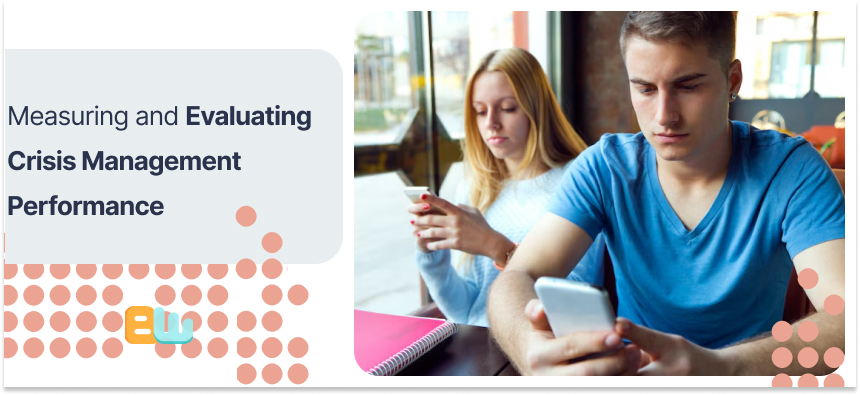
Effective measurement helps organizations learn from each crisis experience and strengthen future response capabilities.
Key Performance Indicators for Social Crisis Response
Establish these metrics to evaluate crisis management effectiveness:
Response time indicators:
– Time to first acknowledgment
– Time to substantive statement
– Update frequency throughout crisis lifecycle
Reach and engagement metrics:
– Mention volume compared to pre-crisis baseline
– Share of voice in crisis conversation
– Ratio of original content to shares/reposts
Sentiment measurements:
– Sentiment shift over crisis timeline
– Ratio of negative to neutral/positive comments
– Recovery to baseline sentiment (duration)
Resolution indicators:
– Time to operational normalization
– Customer service inquiry volume and resolution rate
– Employee satisfaction and retention during/after crisis
Business impact metrics:
– Revenue fluctuations correlated with crisis timeline
– Customer retention compared to normal periods
– Share price recovery (for public companies)
Effective measurement requires establishing baselines during normal operations. Without these comparison points, crisis metrics provide limited insight.
Tools for Assessing Reputation Recovery Post-Crisis
Several specialized tools help track reputation recovery:
YouGov BrandIndex provides continuous brand health tracking, allowing precise measurement of perception changes throughout crisis periods.
Brandwatch Consumer Research offers detailed sentiment analysis across multiple platforms, helping identify which aspects of reputation recover first and which require additional attention.
Awario enables competitor comparison during crises, showing whether reputation challenges have created competitive disadvantages requiring specific attention.
SEMrush’s Brand Monitoring tracks organic search behavior changes, revealing how crises affect information-seeking behavior around your brand.
Qualtrics supports custom reputation research, allowing organizations to directly measure stakeholder perception changes through targeted surveys.
The most effective measurement approaches combine these specialized tools with your existing analytics infrastructure to provide comprehensive views of reputation impact.
Using Analytics to Improve Future Crisis Protocols
Turn crisis data into actionable improvements:
Conduct thorough post-mortems within 2 weeks of crisis resolution. Document what worked, what failed, and specific protocol adjustments needed.
Create response time benchmarks based on actual performance. If your team consistently misses target timeframes, adjust protocols or resources accordingly.
Analyze platform-specific performance to identify where response was most and least effective. This reveals where additional training or resources should focus.
Review message effectiveness by comparing engagement and sentiment across different statements. This identifies which communication approaches resonated with your specific audience.
Map crisis development patterns to identify typical escalation points. This helps create early intervention opportunities in future situations.
Compare internal and external timelines to identify disconnects between organizational awareness and public perception.
Update simulation scenarios based on real crisis experiences. This ensures future training reflects actual rather than theoretical challenges.
The organizations that treat each crisis as a learning opportunity significantly outperform those that simply aim to “get through” reputation challenges.
Future Trends in Social Media Crisis Management

The crisis management landscape continues evolving rapidly. Organizations can better prepare for the problems of the future by understanding emerging trends.
How AI Is Transforming Crisis Detection and Response
Crisis management is changing in a number of ways due to artificial intelligence:
Potential catastrophes are now detected by predictive analytics before they materialize.
Advanced pattern recognition can flag unusual conversation clusters or sentiment shifts that precede major issues.
Automated response systems handle initial acknowledgments for detected issues, reducing critical response gaps while human teams mobilize.
In order to provide fuller crisis context, sentiment analysis tools have advanced beyond the conventional positive/negative classification to identify nuanced emotions like sarcasm, perplexity, and disappointment.
Teams may generate answer variations for various platforms and audiences while preserving message consistency with the use of natural language generation.
By detecting brand-relevant visual content that text monitoring would overlook, image and video recognition captures a more comprehensive crisis landscape.
Even while AI improves skills, human judgment is still crucial for handling difficult reputational issues. The best strategies integrate human empathy, contextual awareness, and technical efficiency.
Emerging Platforms and Their Impact on PR Strategy
New social environments create both challenges and opportunities:
Private messaging platforms continue shifting conversations from public to private spaces, complicating monitoring but offering opportunities for personalized crisis resolution.
Audio-based social networks like Clubhouse introduce real-time crisis dimensions requiring immediate verbal response capabilities rather than carefully crafted written statements.
As businesses develop presence in immersive worlds where negative interactions might feel more personal, augmented reality platforms introduce new categories of reputation risk.
Blockchain-based decentralized networks lessen platform-level moderation, which could prolong the life of harmful content.
Vertical-specific platforms targeting particular professions or interests fragment audience attention but allow for more customized crisis response approaches.
In order to cover these new contexts, organizations need to keep improving their monitoring and response capabilities. Major crises of the future will probably arise from platforms that appear insignificant now.
Preparing for Tomorrow’s Social Media Challenges
Innovative businesses are already tackling new crisis management issues:
In order to satisfy various platform needs, multimodal response capabilities that combine text, image, video, and audio elements are being developed.
Developing crisis protocols for deepfakes, or synthetic media that can disseminate fabricated evidence of events that never happened.
In increasingly fragmented information settings, official communications can be authenticated by establishing blockchain verification systems.
Creating cross-functional teams that combine platform-specific knowledge, data science, behavioral psychology, and traditional communications experience.
Looking toward augmented reality crisis simulations that offer more accurate training for intricate, rapidly evolving scenarios.
During ongoing crises, creating real-time stakeholder feedback mechanisms enables ongoing communications improvement.
In order to adapt to changing communication environments, the firms that are most prepared for future difficulties maintain flexible response frameworks rather than strict standards.
Conclusion
Crisis management has been irrevocably changed by social media, which has given brands new opportunities as well as new weaknesses. Organizations that flourish in this setting blend human judgment with technical skills, strategic planning with genuine communication, and proactive planning with responsive agility.
Keep in mind that opportunities are always present in crises. When brands react with openness, compassion, and tangible action, they frequently come out stronger than before. The way you respond to crises when they arise determines whether you suffer long-term harm or improve your reputation.
Although the social landscape will continue to change, the principles of effective crisis management—being organized, timely, truthful, and human—will never change.
#SocialMediaCrisis #PRManagement
